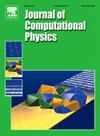A far-field boundary condition for measuring drag force on micro/nano particles
IF 3.8
2区 物理与天体物理
Q2 COMPUTER SCIENCE, INTERDISCIPLINARY APPLICATIONS
引用次数: 0
Abstract
Predicting the flow around airborne particles smaller than 1 µm, which is essential for many air-quality control applications, is challenging because the flow is both rarefied (due to the particle size approaching the mean free path of the gas) and characterised by very low Reynolds numbers (due to the small velocities and length scales involved). The accurate measurement of the drag force on these particles requires the solution of the Boltzmann equation, typically performed using the Direct Simulation Monte Carlo (DSMC) method. In the conventional formulation of these simulations, an accurate value of drag force can only be obtained if the domain boundaries in the DSMC simulation are placed at very large distances from the particle; using small domains can significantly over-predict the drag. The computational cost of DSMC simulations scales with the cube of the domain size for a general 3D flow, making it computationally intractable to measure drag on particles of arbitrary shape in the transition regime. In this work, we propose a boundary condition that emulates the flow conditions at a finite distance from the particle, rather than the free-stream conditions commonly used in previous studies. Our approach exploits the fact that the flow disturbance far from an arbitrary particle, travelling at very low Reynolds number, has a known analytical form that is given by the fundamental solution to the Stokes equations. Employing this boundary condition enables accurate simulations of drag prediction using much smaller domain sizes than otherwise possible, decreasing the computational cost by up to three orders of magnitude. The proposed approach allows the first accurate and tractable calculation of the drag force on slow-moving arbitrary-shaped 3D particles in the transition regime.
测量微纳粒子阻力的远场边界条件
对于许多空气质量控制应用来说,预测小于1微米的空气颗粒周围的流动是必不可少的,但这一预测具有挑战性,因为这种流动既稀薄(由于颗粒尺寸接近气体的平均自由路径),又具有非常低的雷诺数(由于所涉及的速度和长度尺度很小)。精确测量这些粒子上的阻力需要解玻尔兹曼方程,通常使用直接模拟蒙特卡罗(DSMC)方法进行。在这些模拟的传统公式中,只有当DSMC模拟中的区域边界离粒子很远时,才能获得准确的阻力值;使用小域会明显地过度预测阻力。对于一般的三维流动,DSMC模拟的计算成本与区域尺寸的立方成正比,这使得在过渡区测量任意形状粒子的阻力变得难以计算。在这项工作中,我们提出了一个边界条件,模拟了与颗粒有限距离处的流动条件,而不是以前研究中常用的自由流动条件。我们的方法利用了这样一个事实,即远离任意粒子的流动扰动,以非常低的雷诺数运动,具有已知的解析形式,由斯托克斯方程的基本解给出。使用该边界条件可以使用更小的域尺寸进行精确的阻力预测模拟,从而将计算成本降低了三个数量级。所提出的方法允许在过渡状态下对缓慢移动的任意形状三维粒子的阻力进行首次精确和易于处理的计算。
本文章由计算机程序翻译,如有差异,请以英文原文为准。
求助全文
约1分钟内获得全文
求助全文
来源期刊

Journal of Computational Physics
物理-计算机:跨学科应用
CiteScore
7.60
自引率
14.60%
发文量
763
审稿时长
5.8 months
期刊介绍:
Journal of Computational Physics thoroughly treats the computational aspects of physical problems, presenting techniques for the numerical solution of mathematical equations arising in all areas of physics. The journal seeks to emphasize methods that cross disciplinary boundaries.
The Journal of Computational Physics also publishes short notes of 4 pages or less (including figures, tables, and references but excluding title pages). Letters to the Editor commenting on articles already published in this Journal will also be considered. Neither notes nor letters should have an abstract.
 求助内容:
求助内容: 应助结果提醒方式:
应助结果提醒方式:


